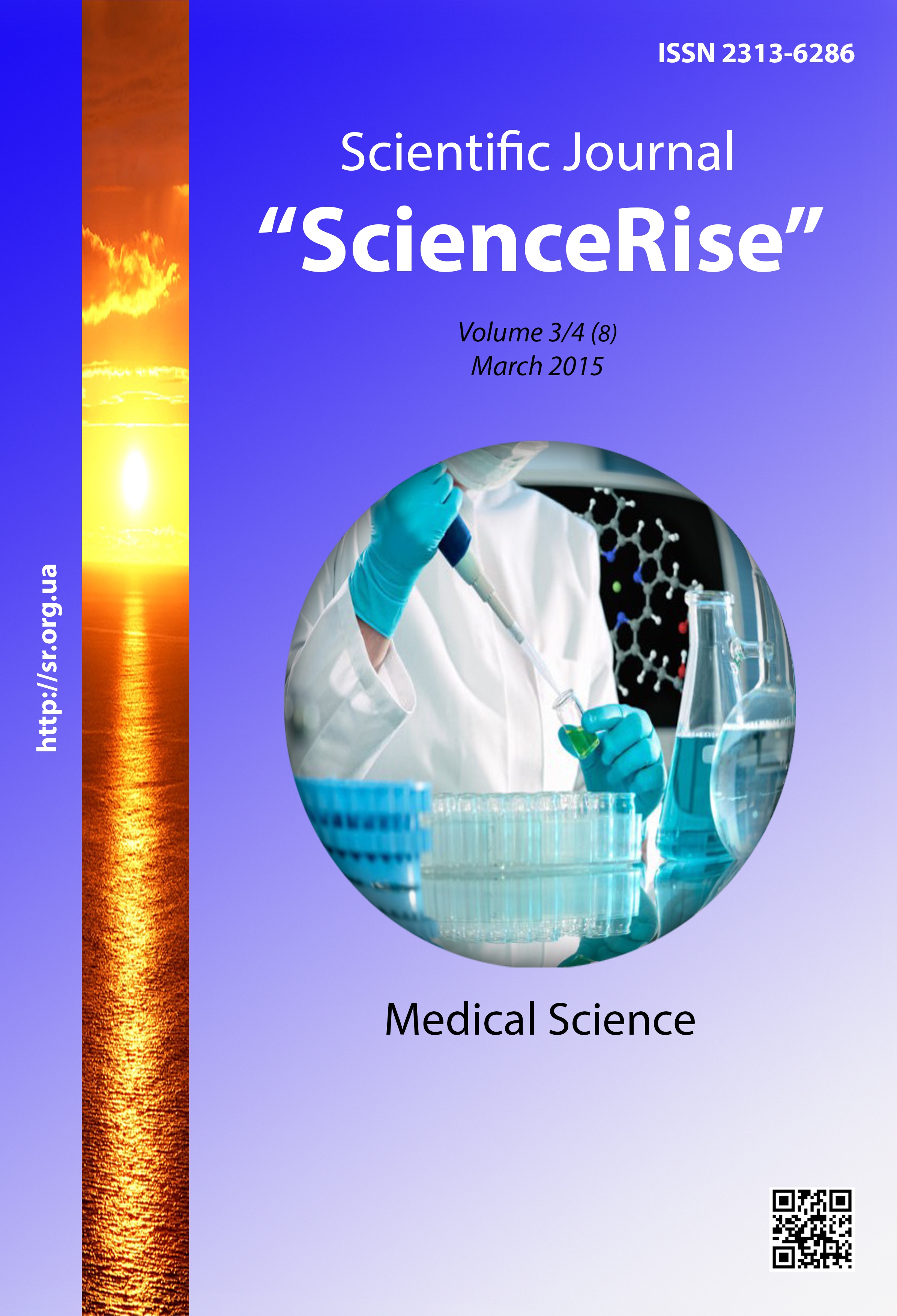Clinical significance of transforming growth factor β1 in the diagnosis of the severity of acute pancreatitis
DOI:
https://doi.org/10.15587/2313-8416.2015.38849Keywords:
transforming growth factor-ß1, acute pancreatitis, severity, diagnosisAbstract
Aim. Determine the clinical-diagnostic and prognostic value of transforming growth factor ß1 (TGF-ß1) at different degrees of severity of acute pancreatitis (AP) on the basis of studying the characteristics of content of anti-inflammatory cytokine in serum to create a diagnostic algorithm severity and course of AP.
Methods. It is analyzed the data for the study of nature of the transforming growth factor ß1 (TGF-ß1) content in the serum of 94 patients with AP varying severity (mild case of AP-20 patients, average case - 12, severe case -62) in the first 24-48 hours and 7-10 days of hospitalization.
Results. Analysis of the data can reliably assert that the value of TGF-ß1 in the first 48 hours of admission to correlate with AP severity. It is proposed the use of TGF-ß1 level in clinical and diagnostic complex of diagnostic of AP severity in the first 48 hours of hospitalization. If the patient has TGF-β1≤70.0 ng / ml it is mild AP. If the level of cytokine ≥70.1 ng / ml produce differentiation between moderate and severe AP. At the level of cytokine ≥120.1 ng / ml it is severe AP and diagnosis is completed. In the case of the definition of TGF-β1 in the range of> 80.1 - <120.0 ng / ml AP degree uncertain and requires further observation and examination.
Conclusions. Diagnostic thresholds of AP severity are determined. It is allowed use of TGF-β1 in a modern complex AP diagnostics. It is proven a diagnostic and prognostic significance level of anti-inflammatory cytokine TGF-ß1
References
Vetschev, P. S., Musaev, G. H., Bruslik, S. V. (2014). Miniinvazivnye chrezkognye tehnologii: istorya, tradicii, negativnie tendencyi i perspectivy [Minimally invasive percutaneous technologies: history, traditions, negative trends and prospects]. Annals of Surgical gepatologii, 19 (1), 12–16.
Veligotskyi, N. N., Arutjunov, S. Je., Kozachenko, A. V. et. al. (2013). Differencyrovannyi podhod k vybory operatyvnech vmechatelstv pri tyagelych formah ostrogo pancreatita [Differentiated hike to the choice of surgical interventions in severe forms of acute pancreatitis]. Kharkiv hіrurgіchna shkola, 2 (59), 56–58.
Krivoruchko, I. A., Bojko, V. V., Andreeshhev, S. A. (2011). Stroky vikonannya hіrurgіchnogo vtruchannya y hvoryh na gostryi necrotychnyi pancreatyt, uskladnenyi vtorynnoy pancreatychnoy infecyeu. [Erms of surgery in patients with acute necrotizing pancreatitis complicated by secondary pancreatic infection] Klіnіchna hіrurgіya, 7, 33–41.
Mihaylusov, S. V., Moiseenkova, E. V., Tronin, R. Ju. (2014). Miniinvazivnye vmeshatelstva pod controlem YZI pri pancreonecroze [Minimally invasive interventions under ultrasound in pancreonecrosis].Annals of Surgical gepatologii, 19 (2), 72–78.
Ganjyi, V. V., Kolesnik, I. P., Matjushkina, I. S. (2012). Diagnostika nekrotycheskoy formy ostrogo pancreatita v pervye 3 sytok posle gospytalizacii pacientov [Diagnosis of necrotic forms of acute pancreatitis in the first 3 days after hospitalization]. Klіnіchna hіrurgіya, 10, 19–22.
Mangiante, G., Rodella, L., Cerofolini, A. (2013). Severe necrotic and septic pancreatitis. Indications to endoscopic, surgical, and nutritional therapy. G. Chir, 34 (9-10), 284–287.
Panek, J., Kuśnierz-Cabala, B., Dolecki, M., Pietron, J. (2012). Serum Proinflammatory Cytokine Levels and White Blood Cell Differential Count in Patients with Different Degrees of Severity of Acute Alcoholic Pancreatitis. Polish Journal of Surgery, 84 (5), 230–237. doi: 10.2478/v10035-012-0038-8
Klimenko, M. V. (2013). Osobenosti cytokinovoy reactyvnosty pri ostrom i chronichtskom pancreatite [Cytokine responsiveness in acute and chronic pancreatitis]. Ukranian magazine surgery, 2 (21), 111–114.
Ito, T. (2007). Can measurement of chemokines become useful biological and functional markers of early-stage chronic pancreatitis? J Gastroenterol, 42 (S17), 72–77. doi: 10.1007/s00535-006-1929-4
Su, S. B. (2000). Expression of transforming growth factor-beta in spontaneous chronic pancreatitis in the WBN. Dig Dis Sci, 4, 151–159.
Yoo, B. M., Yeo, M., Oh, T. Y., Choi, J. H., Kim, W. W., Kim, J. H. et. al .(2005). Amelioration of Pancreatic Fibrosis in Mice With Defective TGF-?? Signaling. Pancreas, 30 (3), e71–e79. doi: 10.1097/01.mpa.0000157388.54016.0a
Viskunov, V. G., Asatrjan, A. A., Procenko, S. I. (2011). Patomorfologicheskiy analiz podgelydochnoy gelezy pri raznyh formah pancreonekroza [ Pathologic analysis of the pancreas with different forms of pancreatic necrosis]. Bulletin of Experimental and Clinical surgery, 4 (1), 135–139.
Menges, P., Kessler, W., Kloecker, C., Feuerherd, M., Gaubert, S., Diedrich, S. et. al. (2012). Surgical Trauma and Postoperative Immune Dysfunction. European Surgical Research, 48 (4), 180–186. doi: 10.1159/000338196
Fomin, P. D., Bereznitsky, J. S., Andryushchenko, V. P. (2012). Udoskonalenі algorithmy dіagnostiki ta likyvannya gostrogo pancreatity (metodechni recomendacii). [Improved algorithms for diagnosis and treatment of acute pancreatitis (guidelines)], Singapore, 80.
Zosimov, A. N., Golik, V. P. (2000) Systemnyi analiz v medecine [System analysis in medicine]. Harkov, "Trnado", 82.
Downloads
Published
Issue
Section
License
Copyright (c) 2015 Михаил Викторович Клименко

This work is licensed under a Creative Commons Attribution 4.0 International License.
Our journal abides by the Creative Commons CC BY copyright rights and permissions for open access journals.
Authors, who are published in this journal, agree to the following conditions:
1. The authors reserve the right to authorship of the work and pass the first publication right of this work to the journal under the terms of a Creative Commons CC BY, which allows others to freely distribute the published research with the obligatory reference to the authors of the original work and the first publication of the work in this journal.
2. The authors have the right to conclude separate supplement agreements that relate to non-exclusive work distribution in the form in which it has been published by the journal (for example, to upload the work to the online storage of the journal or publish it as part of a monograph), provided that the reference to the first publication of the work in this journal is included.

